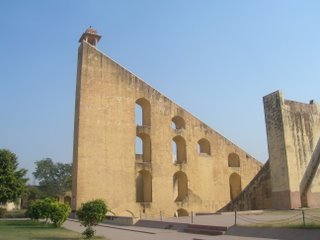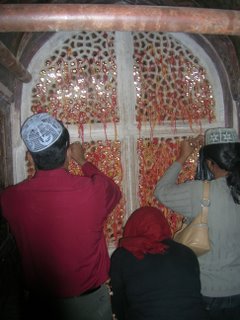Hello everybody - I've just returned from a trip around North India and I have pictures galore for you all. First, we visited Rajasthan (the name literally means "land of kings"), a state bordering on Gujarat that is famous for its palaces and forts. It's also a land of camels, and with that in mind we went on a desert "safari", with everyone riding into the desert on camels and playing in the dunes. Here's me and my friend Sam on a camel named (I'm not making this up) Michael Jackso

n:
Note the coats - it was freezing! Hooray for cold! Because I'm a big fan of Rajasthani turbans - huge bulbous creations in neon colors - I snuck a picture of this guy through the window of the bus. (Hence the water bottle.)

In Jaisalmer, there are tons of old buildings like the one below. The area around the open windows is made up of intricately carved marble screens, so that people inside can see out, but no one outside can see in. This is due to the purdah system, which was prevalent in Rajasthan for hundreds of years and dictated that a woman could not be seen by any men but the ones in her family. In fact, when the queen of Jodhpur (a nearby city) visited England in the early 1900s, the British media went crazy trying to get a picture of her, as she was always completely covered in veils from head to toe. When a photographer snapped a picture of her bare ankle as she was getting down from a car, it made the front page. The outraged royal family immediately bought up every copy of the paper in the country.
The purdah system has been mostly abolished in Rajasthan, and is now seen only in villages. While we drove from city to city, we occasionally passed through small towns with women passing ghostlike through the streets, their faces covered in veils.

 A little background on the Taj Mahal - it was built between 1631-1654 by the Moslem Emporer Shah Jahan as a tomb for his beloved wife Mumtaz, who died giving birth to their 14th (yikes!) child. Apparently the Emperor was devastated at her death - a court chronicler wrote that "before her death the emperor had but twenty white hairs in his beard, but thereafter many more".
A little background on the Taj Mahal - it was built between 1631-1654 by the Moslem Emporer Shah Jahan as a tomb for his beloved wife Mumtaz, who died giving birth to their 14th (yikes!) child. Apparently the Emperor was devastated at her death - a court chronicler wrote that "before her death the emperor had but twenty white hairs in his beard, but thereafter many more".









